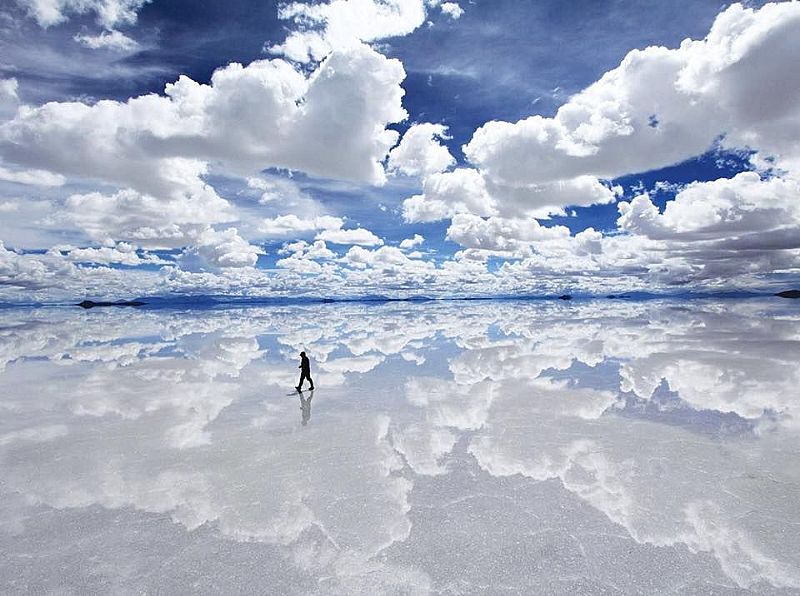In the remote southwest of Bolivia, at the edge of the Andean plateau, lies Salar de Uyuni, the world’s largest salt flat. Spanning more than 10,000 square kilometers, it is a surreal landscape of blinding white salt crusts, crystal-clear reflections, and infinite horizons. Once a prehistoric lake, this otherworldly expanse transforms with the seasons: a dazzling mirror when rains arrive, and a sculpted mosaic of hexagonal tiles during the dry months. Salar de Uyuni is more than a destination it’s a place where reality bends, the Earth seems to dissolve into the sky, and every step feels both intimate and cosmic.
Historical and Cultural Overview
Salar de Uyuni has been shaped over millennia by shifting lakes, volcanic activity, and mineral deposits. Once part of the vast prehistoric Lake Minchin, it became the world’s largest salt flat as the waters receded. The surrounding region has been home to Aymara and Quechua communities for centuries, whose traditions, llama herding, and salt harvesting remain integral to life here. Mining towns emerged in the 19th and 20th centuries, producing silver, tin, and now lithium, leaving traces of industrial history, including the famous Train Cemetery. The flats themselves, with their geometric salt patterns, and the nearby volcanic landscapes, reflect both natural wonder and the enduring cultural heritage of the Andean highlands.
A Landscape of Extremes
Salar de Uyuni is a region of stark contrasts, a land where extremes of nature converge in breathtaking harmony.
- Mirror Season (January–March): After rains, the thin layer of water that blankets the flats turns the ground into a colossal mirror. Walking across it feels like stepping into the heavens, where clouds, sun, and horizon merge into an infinite sky.
- Dry Season (April–December): When the water evaporates, the flats reveal a vast, bright-white expanse. Natural hexagonal patterns form on the surface, creating one of the most photogenic landscapes on Earth.
- Surrounding Wonders: Volcanic peaks, mineral-rich lagoons, and steaming geysers punctuate the region, adding layers of color and life.
- Wildlife Encounters: Flocks of flamingos James’, Andean, and Chilean dot the lagoons, their vivid pink plumage a striking contrast against the mineral waters.
- Cactus Islands: Scattered in the middle of the flats, rocky outcrops such as Isla Incahuasi rise like islands in a sea of salt, covered in towering cacti that have survived centuries of harsh conditions.
What to See and Do
1. Salar de Uyuni Itself



The salt flats are a playground for imagination and photography. Walk across the endless white expanse, watch the sun set in hues of pink and orange, or rise with the dawn to capture the first light reflecting across the mirrored surface. Perspective photography here is a must objects appear to float, vanish, or grow as the horizon stretches infinitely.
2. Isla Incahuasi

This rocky island is home to giant cacti, some more than a thousand years old. A short hike leads to panoramic views of the flats, where the salt stretches uninterrupted in every direction. The island’s unique flora and fauna offer a rare glimpse into life that thrives in this stark environment.
3. Colored Lagoons


- Laguna Colorada: A crimson-hued lake set against volcanic peaks, home to thousands of flamingos. Its vivid red waters are rich in minerals, creating a surreal, almost alien landscape.
- Laguna Verde: Shimmering emerald waters at the base of Licancabur Volcano, the color intensified by mineral deposits and high-altitude sunlight.
4. Eduardo Avaroa Andean Fauna National Reserve
Beyond the salt flats, the reserve is a showcase of Bolivia’s high-altitude wonders. Steam rises from Sol de Mañana geysers, rock formations are sculpted by wind and time, and flamingos feed along mineral-rich shores. Notable landmarks include the famous Árbol de Piedra, a wind-carved rock shaped like a tree.
5. Train Cemetery

On the outskirts of Uyuni town, a graveyard of rusting 19th-century locomotives offers a haunting glimpse into Bolivia’s mining past. The skeletal engines, long abandoned, are a photographer’s dream, set against the endless sky.
Culinary Delights: What to Eat in Uyuni
Bolivian highland cuisine is hearty and flavorful, ideal for refueling after long days exploring the flats.
- Salteñas: Juicy, baked pastries filled with meat, potatoes, and spices a perfect on-the-go snack.
- Quinoa Soup: Nutritious, warming, and locally sourced, quinoa is a staple of Uyuni’s cuisine.
- Trucha (Trout): Freshwater trout from nearby lakes, often grilled or fried with local herbs.
- Chairo: Traditional Andean soup made from beef, potatoes, corn, and vegetables a warming dish for cold nights.
- Api and Buñuelos: Sweet corn-based drink and fried dough, perfect for breakfast or a midday treat.
Mint tea and coca leaves are ubiquitous, aiding acclimatization and offering a comforting ritual at the end of the day.





Where to Stay
Salar de Uyuni offers options ranging from unique salt hotels to rustic refuges and Uyuni town lodgings.
- Palacio de Sal & Luna Salada: Hotels built entirely from salt blocks, combining novelty with comfort.
- Refugios & Eco-Lodges: Simple yet atmospheric, often included as part of multi-day tours.
- Uyuni Town: Affordable hostels and small hotels provide easy access to tours, restaurants, and local markets.
Multi-day tours often include overnight stays in desert lodges or salt hotels, offering unforgettable sunsets and stargazing opportunities far from light pollution.



Best Time to Visit
- Mirror Season (Jan–Mar): For the iconic reflective salt flats.
- Dry Season (Apr–Dec): Easier travel, dramatic salt-crust patterns, and clear skies.
- Weather Note: February rains may complicate travel to Chile; always check tour accessibility.


Travel Tips
- Altitude Awareness: Uyuni sits at 3,656 meters. Acclimatize, stay hydrated, and consider coca tea.
- Clothing: Layered clothing, waterproof boots, sunglasses, and sunscreen are essential.
- Photography: A tripod and polarizing filter are invaluable for capturing the flats’ reflections and sunsets.
- Guided Tours: Independent travel is impossible choose reputable 4×4 tour operators.
- Responsible Tourism: Respect natural paths, avoid leaving waste, and support community-run tours.
The Soul of Salar de Uyuni
Salar de Uyuni is not just a place to visit; it’s a place to experience. Its vastness humbles, its silence inspires, and its light captivates. Walk across the salt crust, stand atop Isla Incahuasi, and gaze at the flamingos dancing on colored lagoons you’ll feel a connection to something larger than yourself. The flats offer both adventure and serenity, challenge and wonder.
Here, time feels suspended. Horizons stretch forever. Stars blaze with extraordinary clarity. And every visitor leaves carrying a piece of the infinite in their memory. Salar de Uyuni is not simply a destination it is a feeling, a dream, and a reminder of Earth’s untamed beauty.
Let the salt flats enchant you, one sunrise, one reflection, one endless horizon at a time.

